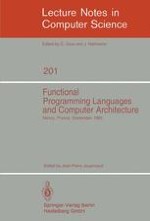1985 | Buch
Functional Programming Languages and Computer Architecture
Nancy, France, September 16–19, 1985
herausgegeben von: Jean-Pierre Jouannaud
Verlag: Springer Berlin Heidelberg
Buchreihe : Lecture Notes in Computer Science
Enthalten in: Professional Book Archive
